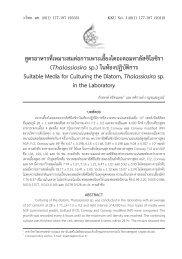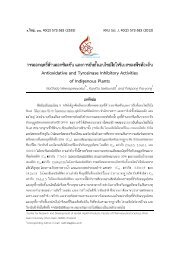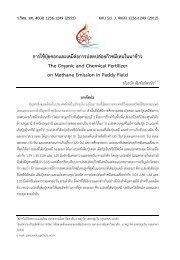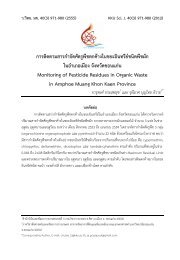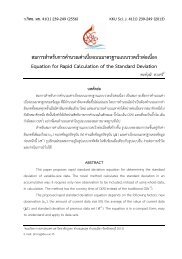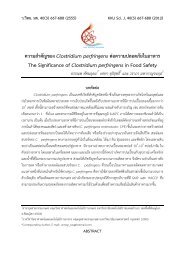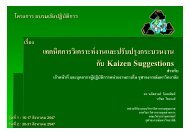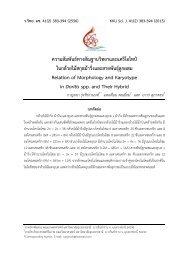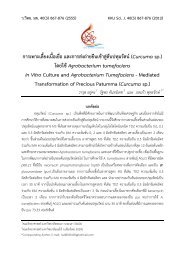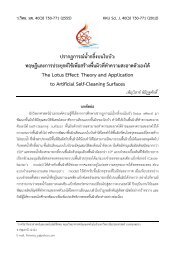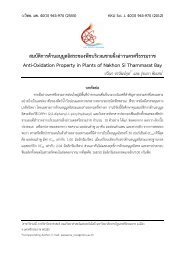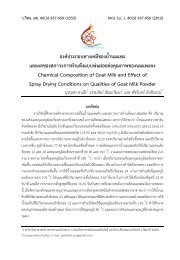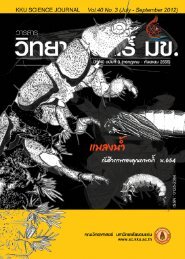Review
Review
Review
Create successful ePaper yourself
Turn your PDF publications into a flip-book with our unique Google optimized e-Paper software.
ß“π«‘®—¬<br />
«“√ “√«‘∑¬“»“ µ√å ¡¢. ªï∑’Ë 39 ©∫—∫∑’Ë 1 81<br />
Abstract<br />
Antioxidant activity of maillard reaction products from chitosan and six types of sugar including<br />
glucose, fructose, lactose, arabinose, maltose, and galactose was investigated. Antioxidant property was<br />
measured the DPPH (2,2-diphenyl-1-picrylhydrazyl) free radical scavenging capacity and measurement of<br />
reducing power. The chitosan-sugar complex or maillard reaction product was measured and its correlation<br />
with antioxidant property was evaluated. Two methods of antioxidant property measurement showed similar<br />
profiles of antioxidant activity. All of the chitosan-sugar complex exhibited better antioxidant activity than<br />
chitosan. The chitosan-arabinose complex and the chitosan-galactose complex showed the most effective,<br />
compared to other sugar complex. The concentration that cause 50% inhibition (IC 50<br />
) of chitosan-arabinose<br />
complex and chitosan-galactose complex were determined to be 26.38 g/ml and 28.50 g/ml, respectively,<br />
while antiradical efficiency were 0.03791 and 0.03509 , respectively. Reducing power of chitosan-galactose<br />
complex was not statistically significant (p>0.05), compared with BHA (Butylated hydroxyanisole). High<br />
correlation between antioxidant activity and browning polymer (A 420<br />
), final stage of maillard reaction, was<br />
observed. Therefore, chitosan-sugar complexes may be use as alternative natural products for synthetic food<br />
additive replacement.<br />
§” ”§—≠ : ‰§‚µ·´π ªØ‘°‘√‘¬“‡¡≈≈“√å¥ “√µâ“πÕπÿ¡Ÿ≈Õ‘ √–<br />
Keywords : Chitosan, Maillard reaction, Antioxidant<br />
∫∑π”<br />
ªí®®ÿ∫—𧫓¡ π„®‡°’ˬ«°—∫ “√‡µ‘¡·µàß<br />
„πÕ“À“√∑’˺≈‘µ®“°∏√√¡“µ‘¡’§«“¡ π„®‡æ‘Ë¡¡“°<br />
¢÷Èπ‡π◊ËÕß®“°Õ—πµ√“¬®“° “√‡µ‘¡·µàß„πÕ“À“√∑’ˉ¥â<br />
®“°°“√ —߇§√“–Àå ‰§‚µ·´π‡ªìπ«— ¥ÿ®“°∏√√¡“µ‘<br />
Õ’°π‘¥Àπ÷Ëß∑’Ë¡’°“√π”¡“„⇪ìπ “√‡µ‘¡·µàß„πÕ“À“√<br />
‡àπ „⇪ìπ “√„À⧫“¡Àπ◊¥ “√„À⧫“¡§ßµ—«<br />
Õ‘¡—≈´‘ø“¬‡ÕÕ√å “√૬‡°Á∫√—°…“°≈‘Ëπ “√૬„Àâ<br />
πÈ”º≈‰¡â„ ·≈– “√૬„Àâ ’§ßµ—«‡ªìπµâπ (Shahidi,<br />
2007) ‰§‚µ·´π‡ªìπæ«°‚æ≈’Õ–¡‘‚π·´§§“‰√¥å<br />
(polyaminosaccharide) ´÷Ë߉¥â®“°°√–∫«π°“√°”®—¥À¡Ÿà<br />
Õ–´‘µ‘≈ (deacetylation) ¢Õ߉§µ‘π ∑”„ÀâÀ¡ŸàÕ–´‘µ“‰¡¥å<br />
(acetamide group) ¢Õ߉§µ‘π ∂Ÿ°‡ª≈’ˬπ‡ªìπÀ¡Ÿà<br />
Õ–¡‘‚π (amino group,-NH 2<br />
) ‰§‚µ·´π¡’‚§√ß √â“ß∑’Ë<br />
ª√–°Õ∫¥â«¬Àπ૬¬àÕ¬¢Õß D-°≈Ÿ‚§´“¡’π<br />
(D-glucosamine) ‡ªìπ’«‚¡‡≈°ÿ≈∑’Ë¡’ ’¢“« ‰¡à¡’°≈‘Ëπ<br />
·≈–¬àÕ¬ ≈“¬‰¥â∑“ß’«¿“æ (Singh and Ray, 1994;<br />
Qurashi et al., 1992) ‰§‚µ·´π¡’§«“¡‡ªìπæ‘…µË”<br />
§à“ LD 50<br />
¢Õ߉§‚µ·´π ®“°°“√∑¥≈Õߥ⫬ÀπŸ„π<br />
ÀâÕߪؑ∫—µ‘°“√ ¡’§à“‡∑à“°—∫ 16 °√—¡/°‘‚≈°√—¡ ¢Õß<br />
πÈ”Àπ—°√à“ß°“¬ ´÷Ëß¡’§à“„°≈⇧’¬ß°—∫‡°≈◊Õ·≈–πÈ”µ“≈<br />
(Kroschwitz, 1990)<br />
‰§‚µ·´π·≈–Õπÿæ—π∏å¢Õ߉§‚µ·´π‡ªìπ<br />
·À≈àߢÕß “√µâ“πÕπÿ¡Ÿ≈Õ‘ √–Õ’°·À≈àßÀπ÷Ëß∑’ˉ¥â√—∫<br />
§«“¡ π„®‡π◊ËÕß®“°‰§‚µ·´π¡’§«“¡ª≈Õ¥¿—¬<br />
“¡“√∂¬àÕ¬ ≈“¬‰¥â∑“ß’«¿“æ §ÿ≥ ¡∫—µ‘„π°“√<br />
µâ“πÕπÿ¡Ÿ≈Õ‘ √–¢Õ߉§‚µ·´π®–¢÷ÈπÕ¬Ÿà°—∫πÈ”Àπ—°<br />
‚¡‡≈°ÿ≈·≈–§«“¡Àπ◊¥ ‚¥¬‰§‚µ·´π∑’Ë¡’πÈ”Àπ—°<br />
‚¡‡≈°ÿ≈µË”·≈–§«“¡Àπ◊¥µË”®–¡’§ÿ≥ ¡∫—µ‘„π°“√µâ“π<br />
Õπÿ¡Ÿ≈Õ‘ √– Ÿß (Kamil et al., 2002; Xie et al., 2001)<br />
®“°°“√»÷°…“§ÿ≥ ¡∫—µ‘„π°“√µâ“πÕπÿ¡Ÿ≈Õ‘ √–¢Õß<br />
‰§‚µ·´π´÷Ëß °—¥‰¥â®“°‡ÀÁ¥ shiitake æ∫«à“¡’§ÿ≥ ¡∫—µ‘<br />
∑’Ë¥’„π°“√‡ªìπ “√µâ“πÕπÿ¡Ÿ≈Õ‘ √– ‚¥¬‡©æ“–§«“¡<br />
“¡“√∂„π°“√®—∫Õπÿ¡Ÿ≈‰Œ¥√Õ°´‘≈ ·≈–§«“¡ “¡“√∂<br />
„π°“√®—∫‡øÕ√— ‰ÕÕÕπ (Yen et al., 2007)



